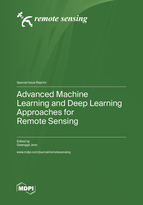Advanced Machine Learning and Deep Learning Approaches for Remote Sensing
A special issue of Remote Sensing (ISSN 2072-4292). This special issue belongs to the section "AI Remote Sensing".
Deadline for manuscript submissions: closed (20 November 2022) | Viewed by 44713
Special Issue Editor
Interests: remote sensing; deep learning; artificial intelligence; image processing; signal processing
Special Issues, Collections and Topics in MDPI journals
Special Issue Information
Dear Colleagues,
Remote sensing is the acquisition of information about an object or phenomenon without making physical contact. Artificial intelligence such as machine learning and deep learning have shown potential to overcome the challenges of remote sensing signal, image, and video processing. Artificial intelligence approaches need huge computing power as they normally use GPUs. Thanks to research efforts, recent advances in remote sensing have led to high-resolution monitoring of Earth on a global scale, providing a massive amount of Earth-observation data. We trust that artificial intelligence, machine learning, and deep learning approaches will provide promising tools to overcome many challenges in remote sensing in terms of accuracy and reliability at high speeds.
This Special Issue is the third edition of “Advanced Machine Learning for Time Series Remote Sensing Data Analysis”. In this third edition, our new Special Issue aims to report the latest advances and trends concerning advanced machine learning and deep learning techniques in relation to remote sensing data-processing issues. Papers of both theoretical and applicative nature, as well as contributions regarding new advanced artificial learning and data science techniques for the remote sensing research community, are welcome.
Both original research articles and review articles are welcome for submission.
Dr. Gwanggil Jeon
Guest Editor
Manuscript Submission Information
Manuscripts should be submitted online at www.mdpi.com by registering and logging in to this website. Once you are registered, click here to go to the submission form. Manuscripts can be submitted until the deadline. All submissions that pass pre-check are peer-reviewed. Accepted papers will be published continuously in the journal (as soon as accepted) and will be listed together on the special issue website. Research articles, review articles as well as short communications are invited. For planned papers, a title and short abstract (about 100 words) can be sent to the Editorial Office for announcement on this website.
Submitted manuscripts should not have been published previously, nor be under consideration for publication elsewhere (except conference proceedings papers). All manuscripts are thoroughly refereed through a single-blind peer-review process. A guide for authors and other relevant information for submission of manuscripts is available on the Instructions for Authors page. Remote Sensing is an international peer-reviewed open access semimonthly journal published by MDPI.
Please visit the Instructions for Authors page before submitting a manuscript. The Article Processing Charge (APC) for publication in this open access journal is 2700 CHF (Swiss Francs). Submitted papers should be well formatted and use good English. Authors may use MDPI's English editing service prior to publication or during author revisions.
Keywords
- machine learning
- remote sensing
- signal/image processing
- deep learning
- artificial intelligence
- time series processing






